The main coffee producing areas in Asia, Indonesia, India, Vietnam, coffee bean flavor differences and story culture

Professional coffee knowledge exchange more coffee bean information please follow the coffee workshop (Wechat official account cafe_style)
Coffee producing areas in the world are mainly divided into three major producing areas: Africa, Asia and America. Coffee varieties, processing methods and flavor are different in each producing area and producing area. The original intention of Qianjie Coffee is to taste coffee beans from all over the world, to understand every coffee variety, every coffee producing area, every processed flavor, to compare and establish a visual database. Qianjie Coffee hopes that every coffee lover can have a better understanding of the coffee world. Today, Qianjie Coffee will introduce the coffee producing areas in Asia. The coffee beans in the Asian producing areas will be mellow.
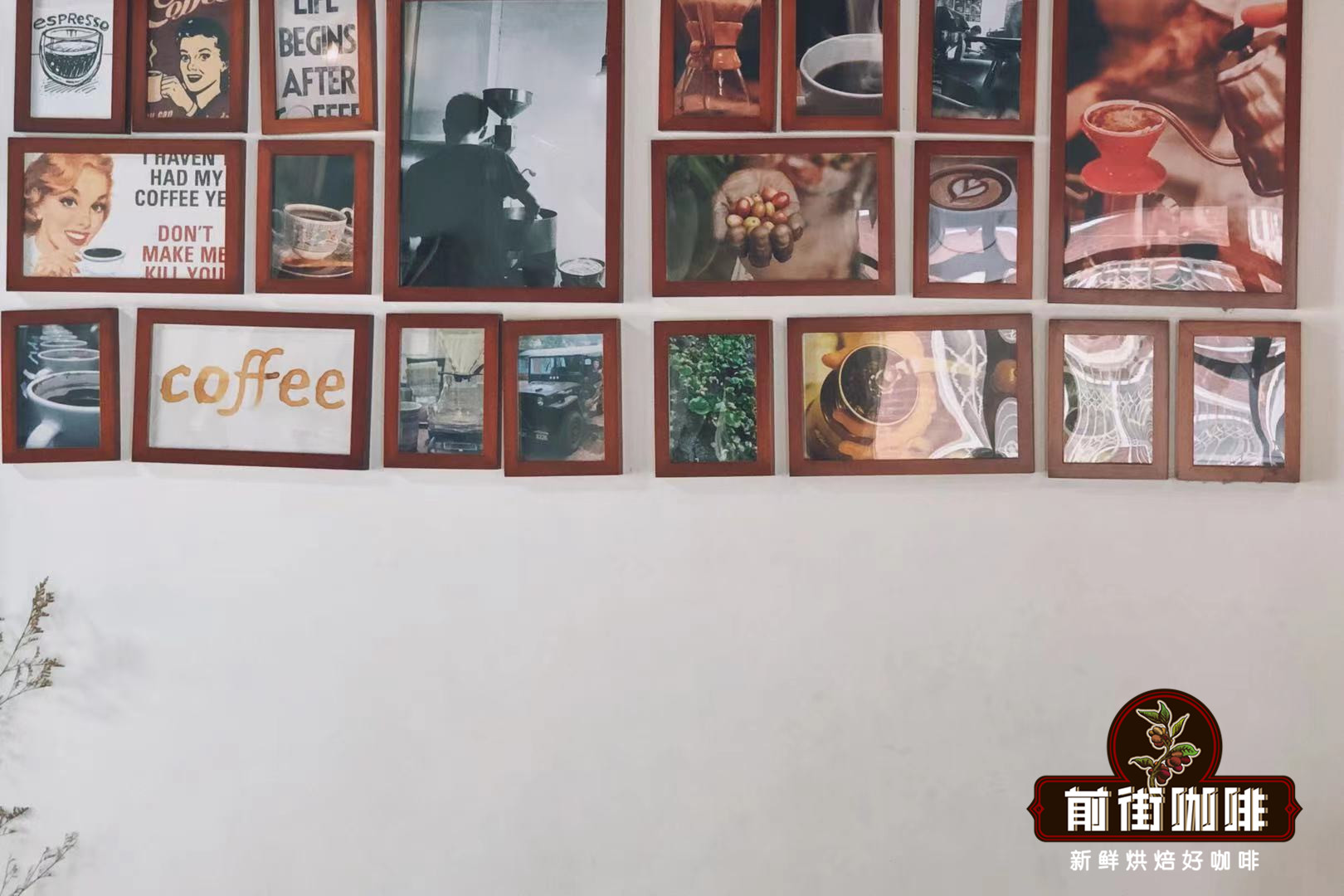
Indonesia
Indonesian coffee development history
Indonesia is located in southeast Asia, its coffee history dates back to 1696, the Dutch introduced coffee beans into Indonesia, after the trial success, they identified Indonesia's Java Island, a large number of coffee beans planted. However, in 1877, almost all coffee trees in Indonesia were infected with leaf rust (bacterial infection), and Arabica coffee beans were unable to resist the disease. Almost all of them were wiped out and suffered heavy losses.
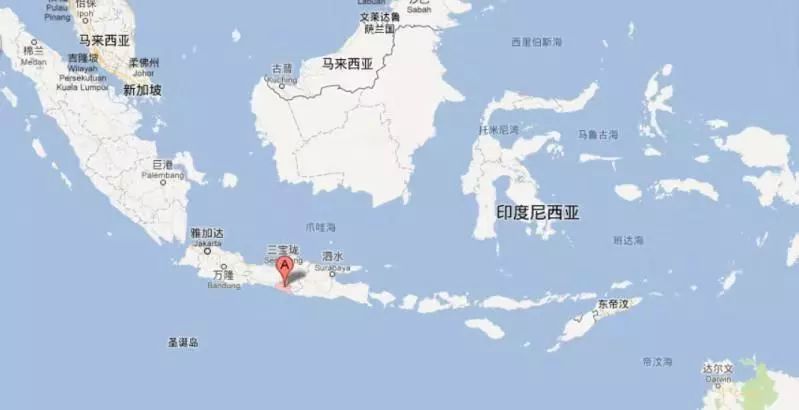
Later, Indonesia had to import robusta coffee beans from Africa. Robusta coffee beans were resistant to disease, which made Indonesia's coffee economy pick up somewhat. Indonesia is now the world's leading producer of robusta coffee beans, while Arabica coffee beans account for only 6% of Indonesian coffee beans, including the familiar Mantenin coffee beans. Robusta coffee beans are grown in southern Sumatra, Indonesia, while Arabica coffee beans are grown in northern Sumatra, Indonesia.
Indonesian coffee growing environment
Indonesia is a typical tropical rain forest climate, with an average annual temperature of 25-27 ℃, no difference in four seasons, and annual precipitation of 1600-2200mm. Indonesia is located in the volcanic zone, the soil is fertile and rich in minerals, which is conducive to the growth of coffee beans. Indonesia is between 9-2100 meters above sea level, and the main coffee-growing areas are concentrated in about 1200 meters.
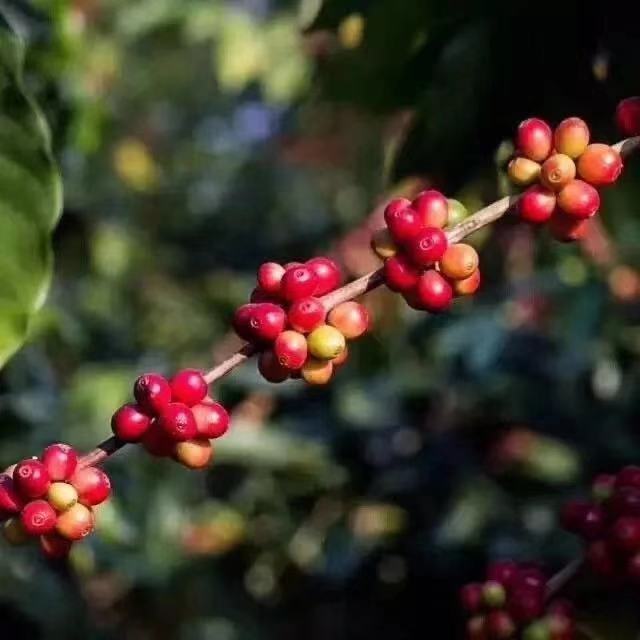
There are two main harvest seasons for Indonesian coffee beans, the main harvest season is about September-October, and the secondary harvest season is from May to June.
Java, I.
Java plays an extremely important role in the history of coffee. Java Arabica coffee, unlike most other Indonesian coffee grown on small farms for initial processing, is grown on large farms or plantations, mostly run by the government. are washed with modern methods. The variety belongs to S795, which is called Jember, by local people and is artificially cultivated.
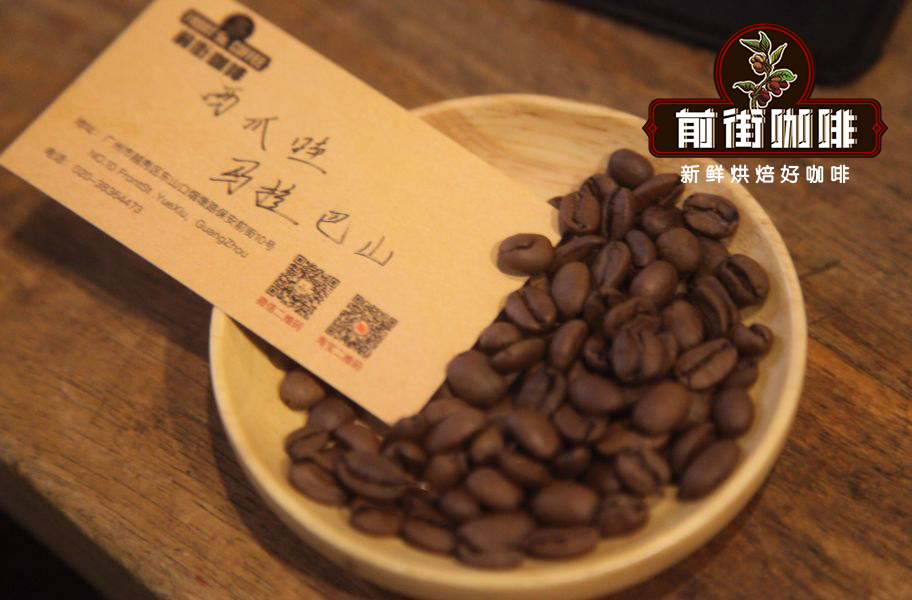
Java produces exquisite aromatic coffee with relatively low acidity, delicate taste and good balance. Java coffee has a better aroma and acidity than coffee from Sumatra and Sulawesi. The best plantations in Java are Blawan, Jambit, Kayumas and Pankur. Java mocha is a mixture of Java coffee and Yemeni mocha coffee.
Java coffee beans have a delicate aroma, relatively low acidity, delicate taste and good balance. Java coffee beans have better aroma and acidity than Sumatra coffee. The climate type of Java is tropical rain forest climate, which is hot and humid all the year round. The plains along the northern coast have the highest temperatures, while the mountains are much cooler. High humidity often creates a debilitating climate. Because it is located in the volcanic zone, the soil in Java is very fertile.
Most of the better quality coffee in Java is located in the western province of West Java, which is a first-class administrative district of Indonesia. It usually comes from state-owned and private estates, which are easier to sell to Europe and the United States because of the support of the government. it's also relatively famous. The plantations are basically above 1400 meters above sea level, supplemented by typical local volcanic soil, creating a unique flavor.
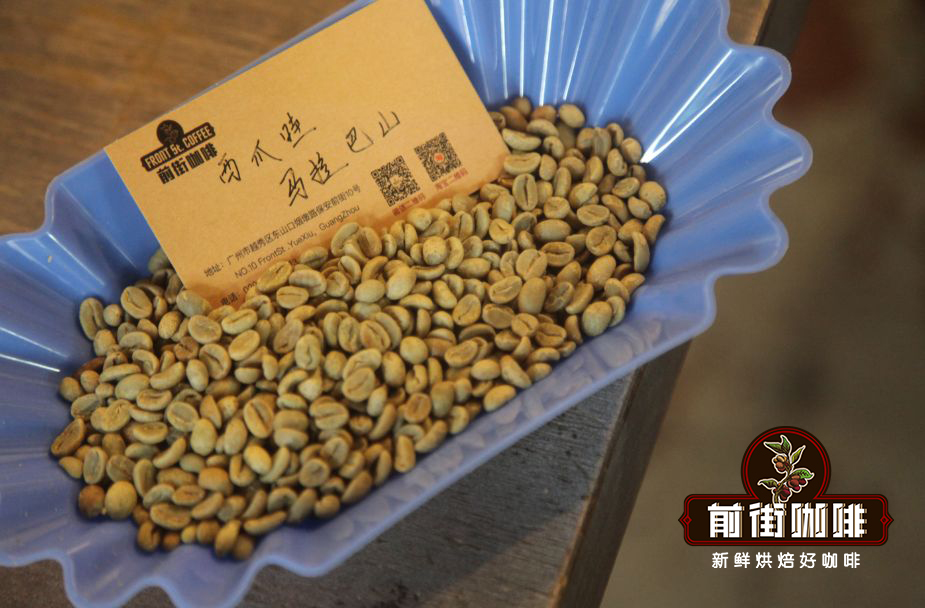
Qianjie Coffee Malaba Mountain, West Java
Producing area: West Java, Indonesia
Altitude: 1400-1800 m
Treatment: insolation
Grade: G1
Variety: TIM TIM, bourbon
Flavor: berries, plums, citrus, cream, hazelnut, sugar, chocolate, oolong tea
Cooking parameters: V60 filter cup, water temperature 90 ℃, powder quantity 15 g, powder / water ratio 1:15, grindness (pass rate of BG#6S,20 standard sieve 70-75%)
Perhaps sharp-eyed readers will see that the parameters of Qianjie Coffee Grinding this Kenyan coffee bean are different from the other beans in front, and the degree of grinding of each coffee bean will be different, because of the variety, altitude, treatment, roasting and other factors. so Qianjie Coffee will sift through it to determine the appropriate hand grinding when it gets a roasted new bean.
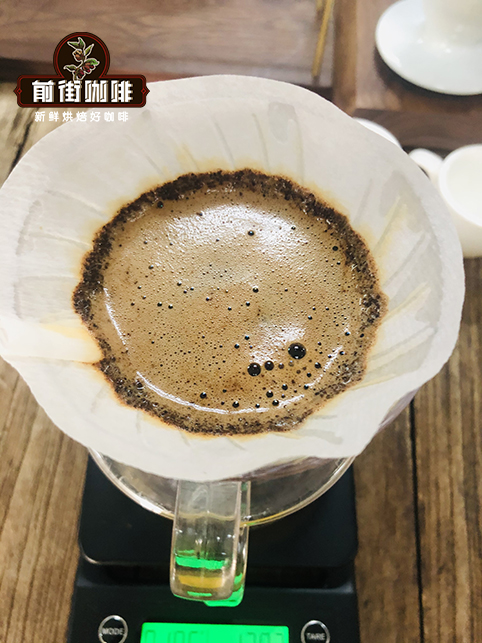
Qianjie coffee is extracted by stages, 30 grams of water is steamed for 30 seconds, small water is injected to 125 grams, water level is about to be exposed when the powder bed is about to be exposed, continue to inject water to 225 grams to stop, (steaming starts) extraction time is 2 minutes 39 times 00 ".
Sulawesi, Pulau
Formerly known as Celebes, Sulawesi is one of the oldest islands in the archipelago, exposing rocks for more than a million years. Soils like yellowish-red ash are found in coffee-producing areas. These soils often have several layers of clay beneath the surface, which are rich in iron. The most famous producing area is in the high mountains of Toraja, which is located in South Sulawesi.
Kalosi, to the south of Tonaga, is the main metropolis of the region, and there are two less well-known areas: Gowa, west of Mamasa and south of Kalosi. A small number of particularly interesting coffee beans are washed with water, which is worth thinking about, and it is highly recommended to try it when you have the opportunity. Semi-washing treatment is a common method in Sulawesi, and the local area also produces a lot of Rob beans. The name of this place is also most commonly used as the representative of Sulawesi Coffee, known for its full consistency, rich flavor and low and lively acidity.
Most Arabica beans are grown high around Tana Toraja, while Kalosi in the south becomes a brand.
* Kalosi: the market name for coffee from southwestern Sulawesi, a small town in the middle of the island, is a central trading place for Toraja (Taroga) coffee beans.
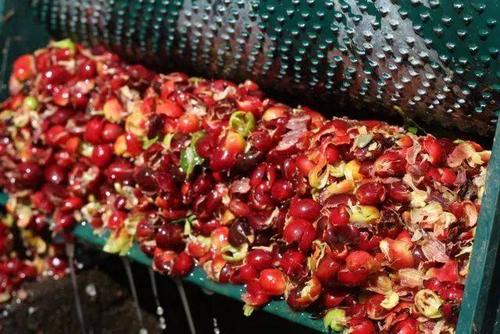
* Toraja: A growing area in the southeastern highlands of Sulawesi, also the name of the island's fine beans. Toraja is not a place name, a city name, or a variety name, but a "Toraga" ethnic group that lives in the central mountain area of western Suvira and is good at growing coffee. Toraga is also a rare high-quality bean in the world, with an annual output of about 1000 metric tons. It is distributed in the rugged slopes of about 1200 meters in the central and southwest of western Suvira. It is not easy to plant and harvest. The average annual output per hectare is only 300 kg, far lower than the average of more than 1000 kg in Central and South America.
The three largest estates in Tonaga are PT Kapal Api with 2000 hectares of coffee plantations, CSR with 1100 hectares of coffee plantations, and Toarco Jaya with 700 hectares of coffee plantations. In other words, Toraja tona is rarer than mantinin or gold mantinin.
Toraja is washed or semi-washed, and has a brighter, more acidic aroma and a more layered feel than Sumatra's or gold's mantelin. It has a strong caramel sweetness, but earthy, woody and mellow flavor is much more restrained than mantelin, slightly floral flavor
Sumatra, Indonesia
The best coffee in Sumatra comes from two places: the Central Asian region near Lake Tawar in northern Sumatra and the mountains surrounding Lake Toba in the south. Due to the large number of smallholder producers and their unique semi-washing methods and the iron deficiency of the soil, coffee beans in this area will have a distinctive blue color at the fresh green stage.
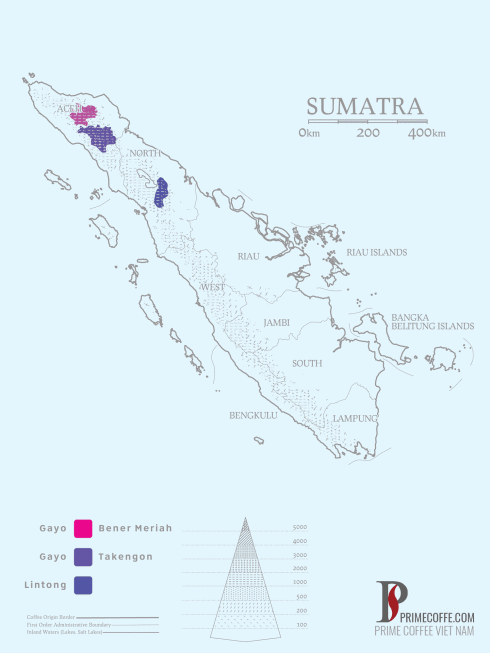
* Mandheling
It refers to the most famous half-sun beans or sun beans around Lake Lake Toba in north-central Sumatra and the Lindong Mountains (Lintong) at an altitude of 900-1200 meters above sea level on the southwest coast. Batak is the backbone of coffee farmers in this area and was once known as the most full-grained coffee beans in the world. Mantenin is a trademark used to produce coffee from Arabica coffee in North Sumatra and Mantenin Mandailing coffee from the Tapanuli area of northwest Sumatra. It has the unique fragrance of herbs and trees.
* Lindong producing area (Lintong)
Lin Dong Manning, 1200 to 1500 meters above sea level, comes from the most famous coffee in Lake Toba on the island of North Sumatra. A correct understanding of Golden Manning Coffee is not golden manning in color or golden manning.
Gold Manning is produced in the Lintong (Lindong) region of northern Sumatra, Sumatra, Indonesia. The harvest operation is limited to picking ripe fruit from a single fruit by hand to ensure the quality of its preliminary selection of beans. Coffee cherries are processed by SEMI-WASHED semi-washing, dried in the natural sun, shelled and then processed through another drying and refining process, two times of raw bean cleaning and four times of Hand-Pick manual selection. Therefore, it can be said that it is a strict selection of top Manning coffee. Huang Jinman marked "PWN" is the abbreviation of Indonesia's Pawani company, whose gold Manning coffee has been registered in Indonesia.

* Lake Lake Toba, located in the central part of North Sumatra, was moved northward by Dutch colonists in 1888 to Lake dopa. The area between Lintong and Lake dopa (Toba lake) in Lindong, South Sumatra can be called mantenin, which is produced in the mountains around Lake dopa (Lake Toba), which is located in the north of Medan, the capital of Sumatra. It belongs to alpine freshwater lakes. The average height is about 900 meters above sea level. Mantenin usually refers to Tibica or its variants of coffee beans grown in the mountains around Lake Toba. The lake is diamond-shaped, 100km long and 30km wide, covering an area of 1130 square kilometers, with an average elevation of about 900m. It is also the largest volcanic lake in the world.
* Lake Tawa, located in the middle of the Aceh Special Administrative region. Located in the northern tip of Sumatra, North Sumatra produces mostly Gayo. Lake Tawa, which is dominated by ateng, can be called Aceh Coffee or Lake Tawa (Tawar lake) coffee. The area is less than 1/10 of Lake dopa. However, the quality and output of coffee have surpassed that of Lake dopa in recent years.
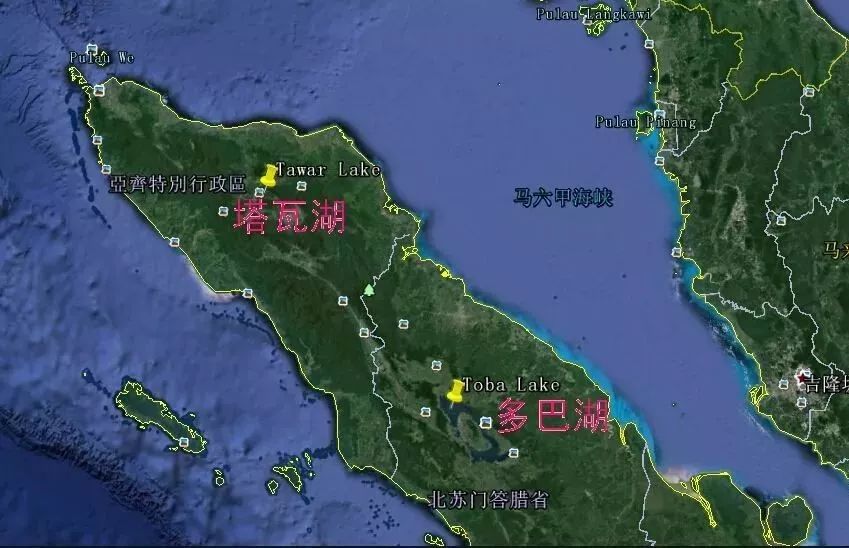
Jiayu Mountain Aceh (Gayo)
Aceh (Aceh), 1110 to 1300 meters above sea level, in the northernmost corner of Sumatra. In Aceh province, north of Sumatra, Gayo coffee is grown on slopes around the town of Takegon and Lake Tawar. The average height in the production area is between 1110 and 1300 meters, and the coffee is planted by shade farmers under shade trees. the wet-processed coffee is cleaner, but usually not as good as Sumatran coffee. The coffee processed by traditional technology is similar to the coffee in Mantenin, Sumatra, with the advantages of peculiar flavor and low and lively viscosity.
Aceh has a long history of political instability, so it is not an area that most people will visit. Gayo people are people with a firm personality and hard work, and nearly 20% of coffee processors are women.
Due to the low altitude and soft beans of Mantenin coffee, Qianjie coffee will mostly choose medium and deep roasting to highlight its chocolate, caramel flavor and mellow taste. So both Italian style and hand flushing are quite suitable.
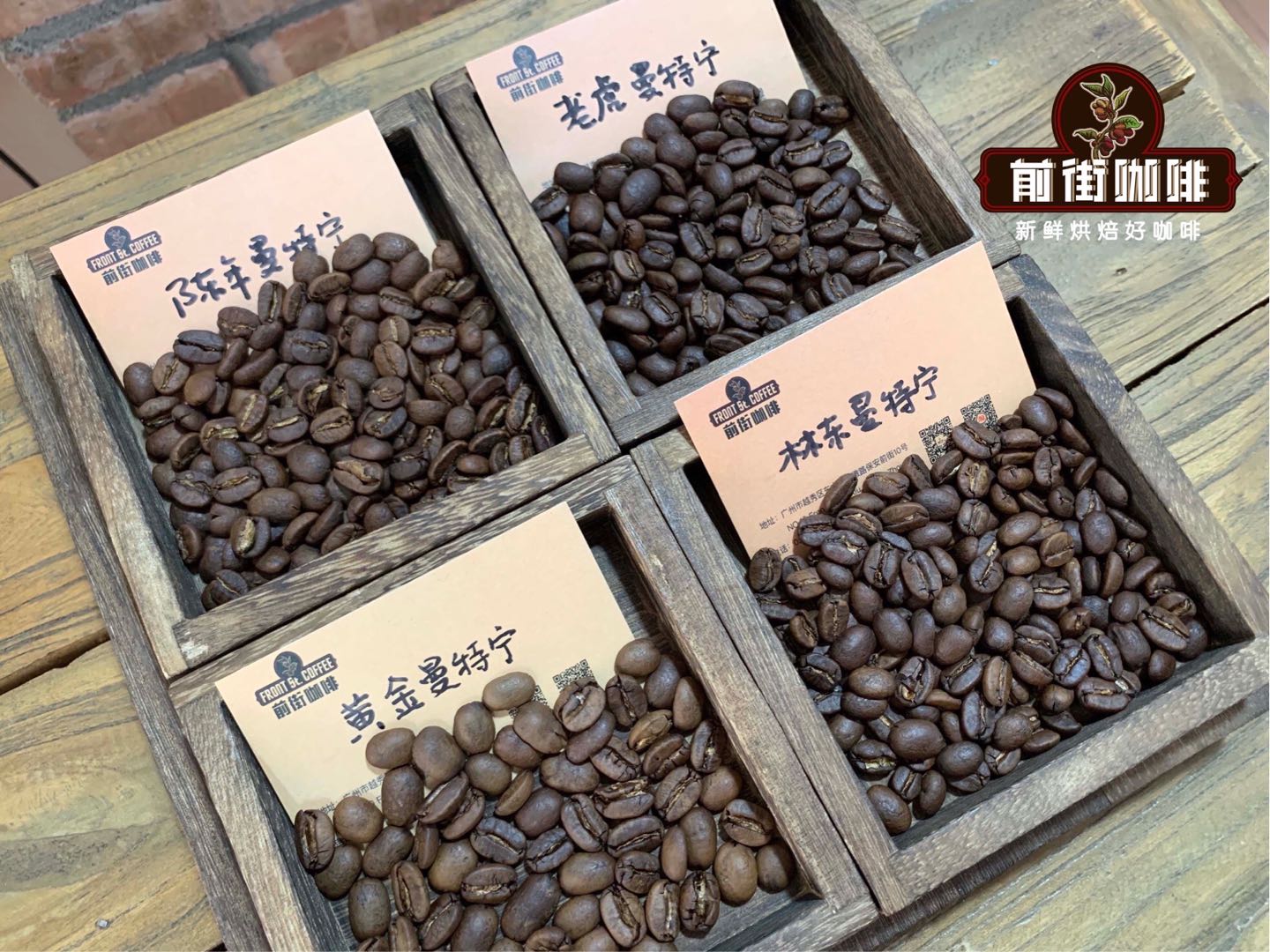
In the hand, for example, Qianjie coffee is recommended to use kalita ladder filter cup or kono filter cup to brew, because this kind of filter cup flow is slow, can play the role of soaking, brewing with a large flow of slow way to reduce stirring, let it soak the extraction, so that it can reduce the chances of over-extraction and improve its alcohol thickness and sense of balance, grinding degree of choice of moderate grinding, water temperature choice of 86-88 ℃, powder / water ratio of 1:13-1:14.
FLORES
Flores is a small island about 320km (200miles) east of Bali, located in one of the Indonesian archipelago, 1200 to 1700 meters above sea level. As a latecomer to the coffee industry, it has also developed a good reputation for growing coffee.
In the past, it was common to see that a large part of Flores's coffee was sold domestically or mixed with other coffee exports, rarely sold directly in the name of "Flores Coffee". There are active and dormant volcanoes on the island, and the mixture of Bajawa volcanoes has a great positive impact on the main planting areas. In terms of coffee processing, the semi-washing process is the most common treatment in the region, and some coffee beans still produced by full-water treatment are harvested from May to September.
Timor Island (Timur)
East Timor is divided into East Timor and West Timor, which originated in the early 20th century. East Timor has not used chemicals or chemicals in the past 25 years and is supposed to be the largest producer of organic coffee in the world, but because the political situation in East Timor is not very stable, it is difficult to export. Most of the beans available now are from West Timor.
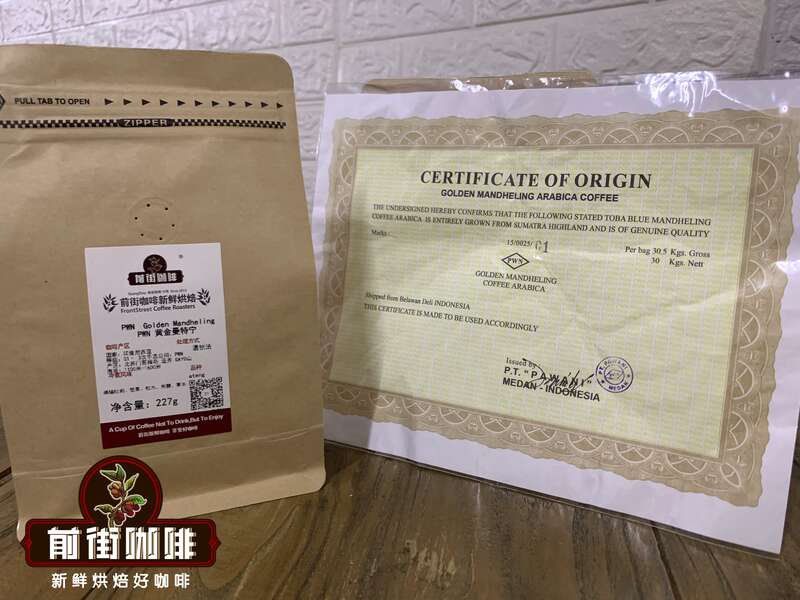
Bali Bali
Although they are members of Indonesian coffee, coffee farmers in Bali feel that the quality of Indonesian coffee is uneven and does not match the quality of Bali coffee, so they set up their own doors and call themselves "Balinese coffee" to show the difference between Indonesian coffee and Indonesian coffee. Bali is not only rich in Arabica coffee beans, but also rich in robusta coffee. According to data, Bali Golden Coffee is made by grafting the roots of Arabica coffee trees and the branches and leaves of Robesta coffee, commonly known as Katim.
Coffee came to Bali relatively late. It was originally grown on the Kintamani Plateau, 1000 to 1500 meters above sea level. Coffee production was deeply affected by the eruption of Gunung Agung in 1963, killing more than 20, 000 people and extensively destroying the eastern part of Bali. In the late 1970s and early 1980s, the government distributed Arabica bean seedlings to boost coffee production, but some thought the effect was limited because about 80% of the island's production today is robusta beans. Although tourism provides the largest income, agriculture employs the most people on the island, while in the past the biggest buyer was Japan, with a harvest period from May to October.
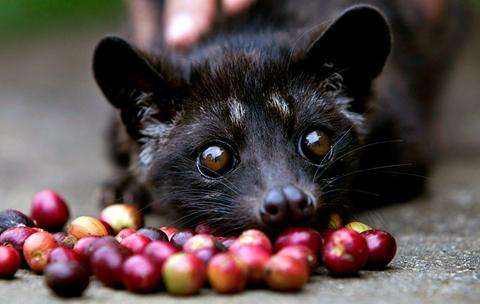
* Coffee Coffee (Luwak)
Civet coffee, coffee from Bali, is not famous for its source, but for its unique processing mode with a unique new method of treatment. a mammal called civet, after eating ripe coffee berries, is digested only the pulp of the fruit appearance, and the hard coffee beans will be discharged from the body through several processes such as manual selection, cleaning, drying, deodorization, screening, processing and roasting. It becomes "Kopi Luwak". This kind of coffee is one of the rare and most expensive coffee in the world because of its low yield and its rarity and special taste.
Now some companies simply create a product called "Kopi Luwak", which feeds civets with coffee and cherry fruit through artificial breeding. Wild musk cats were kept in iron cages for three years and were constantly fed and excreted coffee kernels, many of which caused malnutrition, psychological trauma and other problems (zoochosis), unable to adapt to nature and died.
The front street coffee tells you how to drink civet coffee.
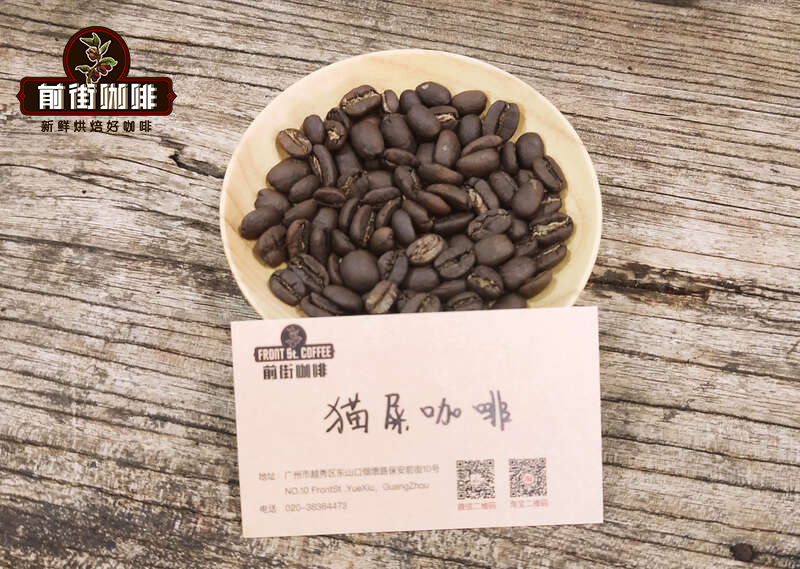
Moderate grinding, powder quantity 15 g, ratio of water to powder 1:15, water temperature 86 ~ 88 °C
1. Wetting filter paper
2. Add powder and gently pat and flatten
3. Steam 30 grams of water for about 30 seconds.
4. circle water injection extraction, water volume up to 125g, pause for a while
5. Again slowly circle and inject water 225 grams.
6. when the water falls completely, you can enjoy it by removing the filter cup.
Soil type
The soil in Aceh, Bali, Papua and Flores highlands is mainly Andosols, and the rules of word formation come from the Japanese words "an" (black) and "do" (soil). These fresh soils come from volcanic soil and are highly fertile and contain important micronutrients. In Arabica coffee in the Java and Lintong regions, the soil is a combination of Andosols and Umbrisols. Umbrisols is a kind of weathered volcanic soil mixed with a considerable amount of organic materials like brown ash.
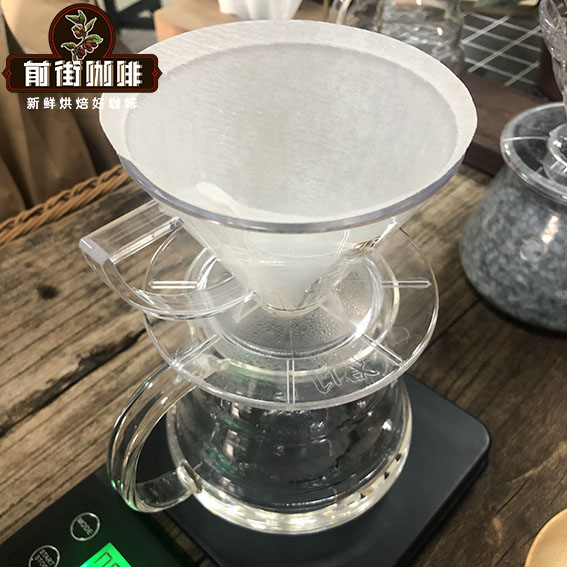
Variety
There are more than 20 varieties of Arabica coffee in circulation in the Indonesian commercial market, including Kaddura, Katim, East Timorese, Ironka, Robsta, Liberika and Ekselsa and Sidikalong. The most famous is Typica, an original breed introduced by the Dutch. When Indonesian coffee suffered from leaf spot disease, many Typica species of iron pickup disappeared in the late 1880s, but two local varieties of iron pickup, Bergandal and Sidikalang, can still be found in Sumatra, Sulawesi and Flores, especially in high altitude and remote areas.
Another kind is horse face Longberry, also known as TimTim, is a bean from Indonesia, because of its long shape, many people call it horse face bean, and some people call it long strip Manning. In fact, tim tim is not a purebred bean, but a natural cross between Arabica coffee and Robusta coffee, which was discovered on the island of timor in the 1940s and cultivated for its natural disease resistance. In America this variety is called Hybrido de Timor, or Tim Tim for short, and in Indonesia it is also called Bor Bor.
After the coffee beans have been screened for particle size, some producers will store the coffee for one to three years before selling it. This process will give the coffee a very mild and warm nature, with woody and cinnamon aromas. Fresh beans will slowly change color from dark yellow to brown.
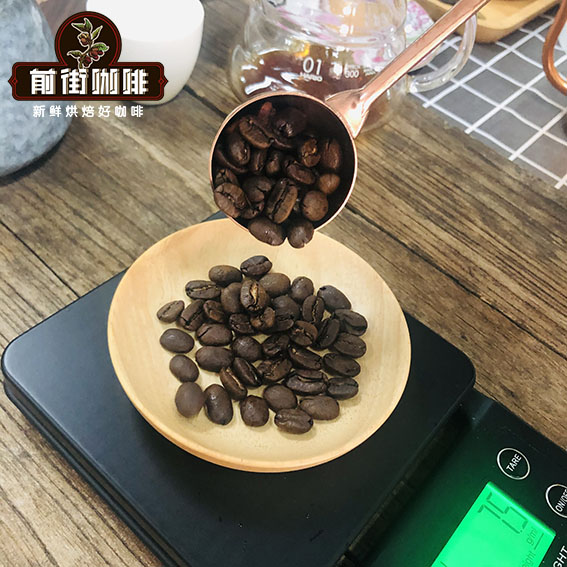
Treatment method
The three main treatment methods are: sun drying, semi-washing, complete washing, because the climate is humid, Rain Water is frequent, in order to pursue more efficient drying, the commonly used wet planing method. Most coffee farmers also harvest only all-red coffee cherries. After collecting coffee cherries in the morning, coffee cherries will be peeled and peeled in the afternoon. Sumatra has a superior natural environment, and most of the water used will be mountain spring water.
1. Peel the coffee fruit, put the shell beans into a vat or sink filled with water, and remove the defective shell beans floating on the liquid surface.
2. Wash the dense shell beans sunk to the bottom of the water slightly, put them into a bucket or plastic bag, and do a little dry body fermentation, that is, to ferment and flavor the pectin sugar on the surface of the seed shell. Basically, the longer the fermentation time, the more sour. The fermentation time varies from person to person, generally only a few hours, but some manors omit the dry body fermentation stage and directly expose the shell beans, which can always be sour and improve the sticky taste, so that the pectin sugar can be fully fermented to increase the flavor, usually between 12-36 hours, depending on the specific situation.
3. When the bean with shell is exposed to the sun for one or two days, the moisture content of the bean body is 30% 50%, and the bean body is still semi-hard and semi-soft. Wipe off the seed shell with a shell planer to speed up the drying process. After about two days, the moisture content of the bean reaches 12% Mui 13%. The coffee beans will be collected into a woven bag, usually 40 kg and 80 kg each, and will be sent to the coffee processing factory for shelling, and the success will be completed in about four days.
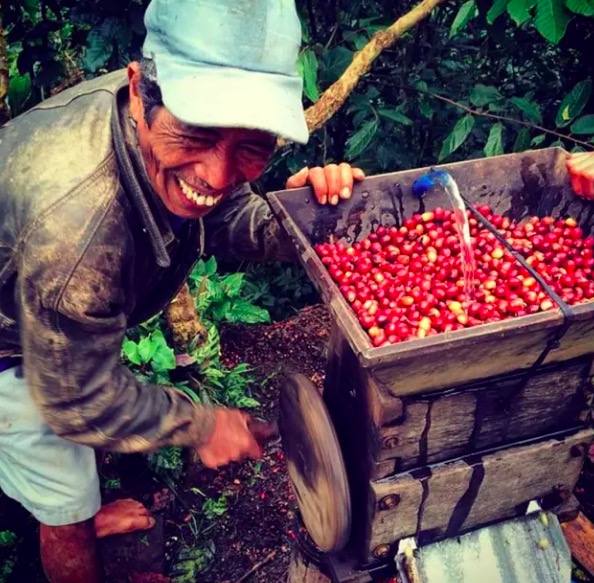
The risk of wet planing: beans are easily cracked like sheep's hooves, and the chances of unmanned molds, fungi and yeasts are also greatly increased.
Raw bean grading
Defective beans are an important factor that destroys the flavor of the final coffee. Therefore, defective beans should also be removed in the last step of raw bean processing. Therefore, according to the proportion of defective beans, supplemented by the size of the screen is also used as a way of classification. Due to the rise of boutique coffee, coffee producing countries pay more and more attention to the quality of coffee, and the control of defective beans is the most important way, so basically using the proportion of defective beans as a grading method or auxiliary basis is becoming more and more common. Indonesian coffee beans are classified according to the proportion of defective beans. Indonesian beans are mainly divided into six grades, namely G1-G6.
Classification according to defect rate (based on 300g), grade Grade standard:
The total defect of G1 Grade1 is less than 11
G2 Grade2 total defects are greater than 12 and less than 25
G3 Grade3 total defects are greater than 26 and less than 44
Total defects of G4a Grade4a are more than 45 and less than 60
Total defects of G4b Grade4b are greater than 61 and less than 80
G5 Grade5 total defects are greater than 81 and less than 150
Total defects of G6 Grade6 are greater than 151and less than 225th.
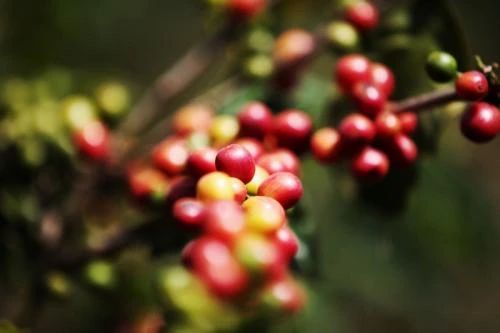
India
Coffee cultivation in India is mainly located in the south, with moist mountain terrain, 800-1600 meters above sea level, few coffee producing areas in the world have as rich a variety as here: forests, herbs, shrubs, flowers and animal groups, to form a magnificent paradise. It is generally tropical in summer and cool in winter, providing an excellent environment for all coffee farmers. Coffee blooming is a spectacle worth experiencing. Throughout the flowering season, people can see the landscape dotted with white flowers, emitting an attractive fragrance, bees and butterflies flying among the flowers. The coffee flowers in the whole area are covered with a sea of white flowers, just like the jewels on the coffee farmer's crown.
Production condition
You might not imagine that India produces a lot more coffee than Ethiopia or any other Central American country-900000 hectares of land grows coffee beans. India has about 140000 coffee farms, more than 90% of which cover an area of less than 10 mu, belonging to small-scale farming. These farms are distributed in the coastal mountains of the south and east, with an annual output of between 44 and 450000 bags, making them the fifth largest coffee producer in the world. Almost 80% of the country's coffee production will be exported to Germany, Russia, Spain, Belgium, Slovenia, the United States, Japan, Greece, the Netherlands, France, Italy and other places, and most of the exported coffee beans will be transported through the Suez Canal.
Producing area
Karnataka, Clara and Tamil Nader are the main coffee producing areas in India, accounting for more than 90% of the country's coffee production. Today, 2 of Indian coffee 3 is Robusta, while Arabica accounts for only 1 Compact 3. Coffee is mainly distributed in Karnataka in the southwest, and both are grown, accounting for 50% of India's total coffee production; Clara in the south focuses on Robusta, accounting for 30% of the total production; Tamil Nader in the southeast grows both, accounting for 10% of India's total coffee production; the remaining 10% are scattered in the emerging areas of the north.
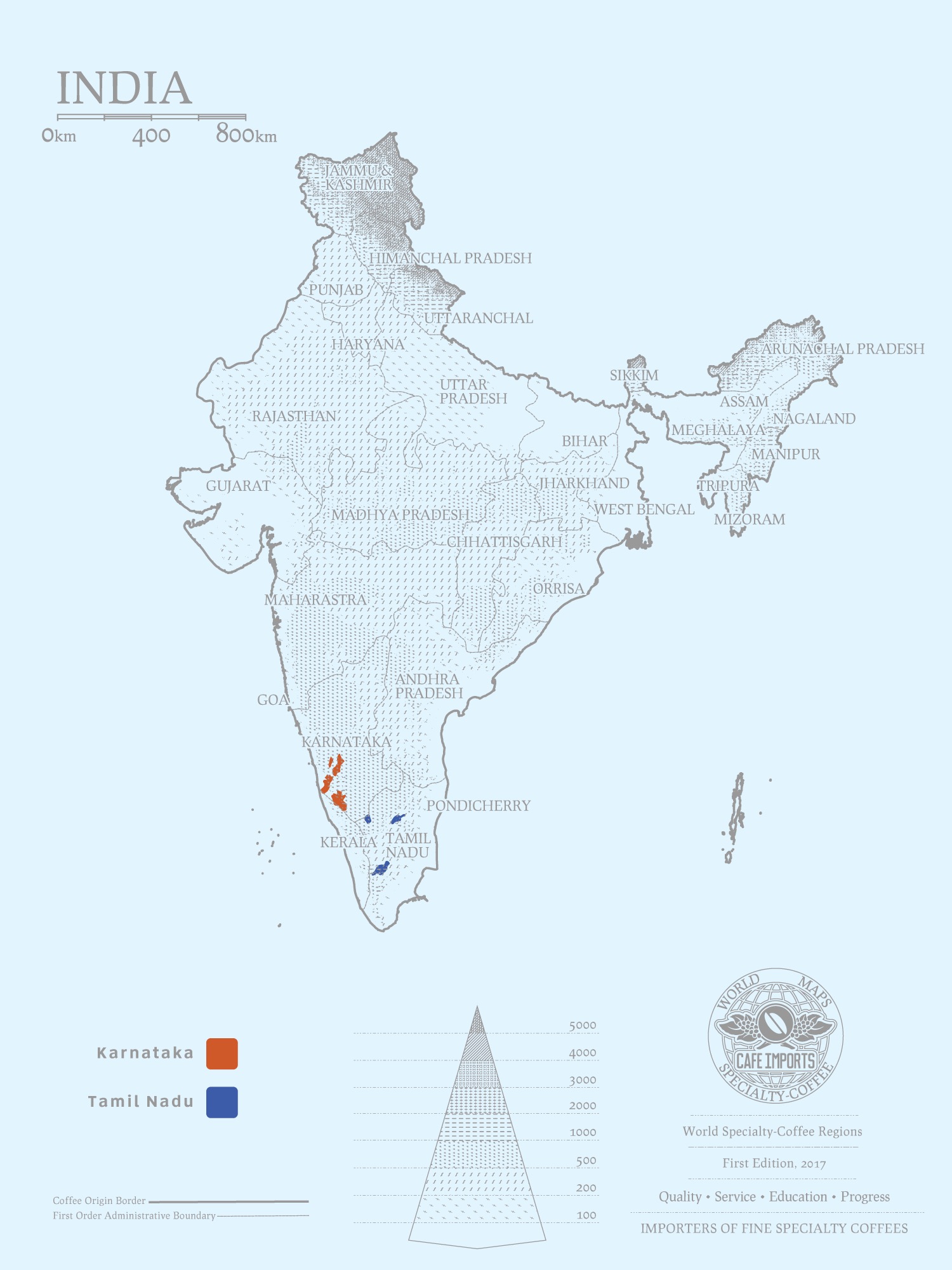
Planting variety
[Kent] (Kent)
The Tibica hybrid, a hybrid of S288 and iron pickup, was found in the Kent Cafe Garden in Mysso, India in 1911, with high yield and rust resistance. The aroma of coffee is thicker than that of bourbon, and it has been introduced to new world producing countries such as Kenya and Indonesia.
[S795]
This variety was bred by crossing Kent Kent (Typica selection, tall, high yield, extremely resistant to leaf rust) and big fruit coffee Coffea Liberica in India in 1940s. 1955 the Indonesian Coffee and Cocoa Institute (ICCRI), named Jember, is widely grown in India, Indonesia and Ethiopia. This variety has some resistance to coffee leaf rust, but the resistance decreases with time and has the taste of maple syrup or brown sugar. S795 is currently the main variety in India, accounting for 70% of the total output of Arabica.
[S274]
India's most famous small seed Robusta, sold on the market as the Royal Robusta Robusta Kappi Royal, is the noblest Luodou in the world. This Kappi Royal,16/17 is the size of the eye, the surface is clean, the beans are hard and chubby is very beautiful. Compared with ordinary sun-dried Luodou, Kaapi Royal has no irritating astringency, fishy smell, or even rubber taste. Some people say that she has the taste of Japanese Xuanmi tea. It is said that drinking alone is not like coffee. It is full of tea and has a high consistency.
[Sln C × R]
This is India's latest espresso formula bean, jumping out of the Arabica and Robusta hybrid, but by the Congolese Sith Congensis and Robusta hybrid, namely Congensis × Robusta. At present, this coffee has entered the American boutique coffee industry, using sun treatment, tastes like Indian spice, slightly sour fruit, and is said to have a very different experience. Sln C × R is expected to be a strong rival to Wind-stained Malaba and Royal Robusta.
Treatment method
Wind-stained Malaba-- A wonderful work in the Great Navigation Age
As early as the 17th century, India was already an important supplier of coffee to Europe in addition to the Yemeni port of Moka. At that time, most of the Indian coffee beans were shipped by sail to the European continent on a voyage of about six months.
During the voyage for more than half a year, due to the sea breeze and absorbing the moisture and salty smell from the cabin, the coffee beans changed in appearance and taste: the appearance of raw beans will gradually change from dark green to yellowish brown like rice, and the beans will swell.
The acidity of the coffee is smoothed out in the process and replaced by the development of flavors such as nuts, caramel and tea (this ripe taste shift is also a bit similar to the aged beans of Sumatra), as well as a thick taste. Indian-style soy beans do have their own unique flavor, usually with a strong sweet taste of nuts and grains, almost sour, often with the aroma of Xuanmi tea, and it is said that Nordic people liked this special golden coffee very much at that time.
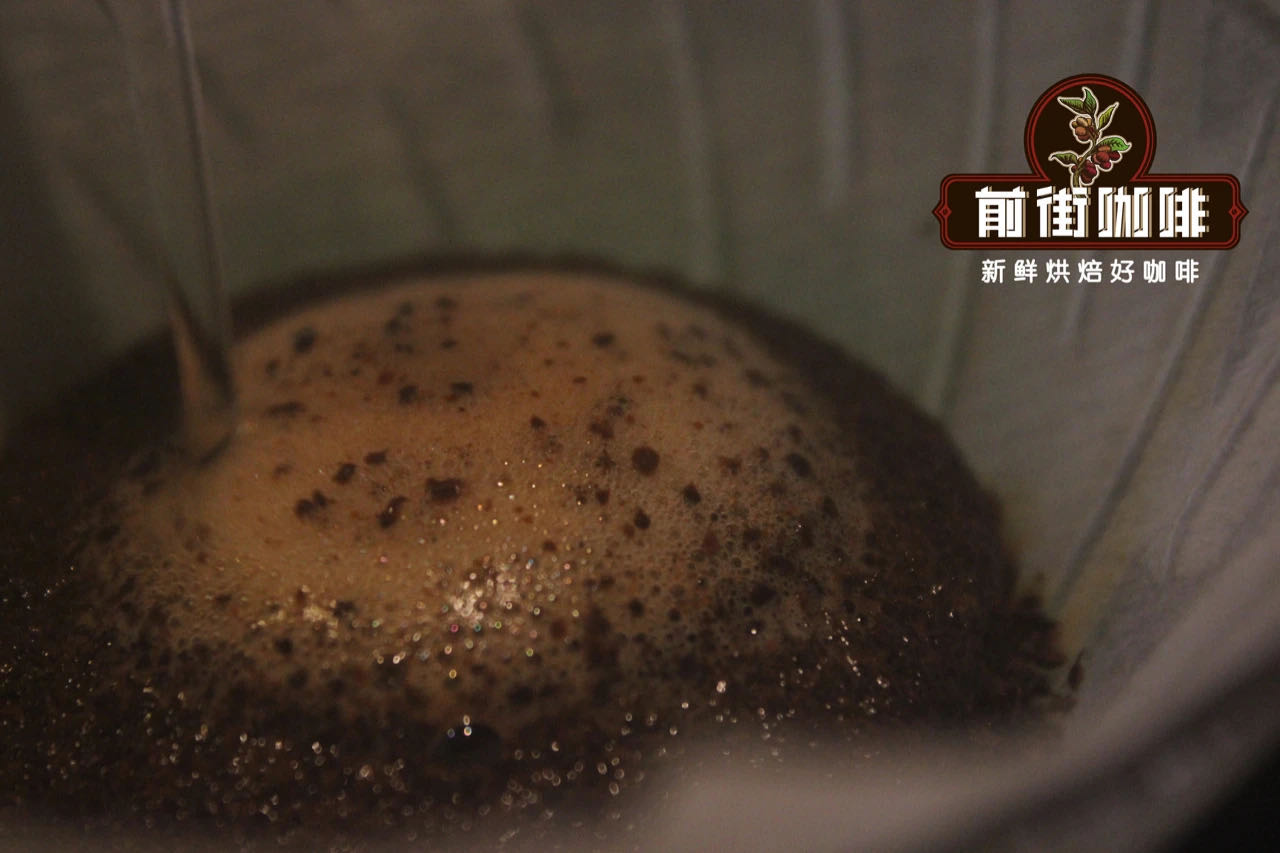
Coffee traders who are proficient in business certainly feel the demand of consumers in the market. Interestingly, when the Suez Canal opened in 1869, coupled with the advent of steamships, the time from India to Europe was greatly shortened, which was supposed to be much more profitable for businessmen to sell Indian coffee. Unexpectedly, European customers complained that the coffee was stale, resulting in a sharp drop in orders.
To investigate the reason why regular customers do not buy it, it turns out that the opening of the canal makes the sailing time too short, and the short delivery time of two or three months makes it too late for the flavor to be "ripe." Without the blessings of the sea breeze, the gluttons do not like it! At this time, the merchant discovered that this accidental delicacy turned out to be a masterpiece of the four hands of the ocean and time.
As a result, this magical country invented the wind-soaked method, which is the open-hanging treatment of the world.
Wind-stained coffee needs to be made with sun beans, and all factories dealing with wind-stained coffee face to the west to meet the salty and wet monsoon blowing from the southwest sea. The coffee beans are spread flat in the wind field, the windows are all open, and the wind stains to a certain extent, and then enter the bag, but because the beans will expand a lot in the process, the coffee beans can not be filled too full, and the coffee bags should not be piled too dense to avoid mildew and spoilage due to lack of wind. It is also necessary to pour out coffee beans and replace sacks from time to time to avoid mold, which is a very time-consuming and labor-consuming project.
Monsoon coffee is stored in a special warehouse until the monsoon arrives, and the ventilation structure is designed to allow the moist monsoon to circulate between the coffee beans, so that its volume expands and shows a mellow but strong mildew smell.
The weathering period is about 12 to 16 weeks, and after it is ripe, it will be fumigated to drive out the weevil, and finally the beans will be screened manually to remove the failed beans that have not turned golden. After three to four months of wind treatment, green coffee beans are twice as large in volume and reduced in weight and density.
The monsoon process is labor-intensive: coffee is spread out in special ventilated warehouses and raked or turned by hand to allow coffee beans to absorb moisture in the moist wind. The whole process takes 12 to 16 months, in which the coffee beans expand to twice their original volume and have a dull golden yellow. Then the coffee beans that are not fully inflated are picked out with extra processing, and the rest of the coffee is to be exported.
Although the wind-stained Malaba coffee beans seem to be big and fat, they are soft beans that are strong and dry outside, a change brought about by months of weathering. Coffee beans have been exposed to the moist monsoon for several weeks, which not only turns the beans yellow, but also reduces the acidity of the coffee itself, and the taste is very special. In addition to serving as a single product, Indian Malaba coffee beans are also suitable for blending integrated coffee beans.
Qianjie coffee will choose medium and deep roasting to roast Malaba coffee, but because of the special treatment, the color after baking is very light, and the roasting chromaticity is quite different from the normal roasting degree.
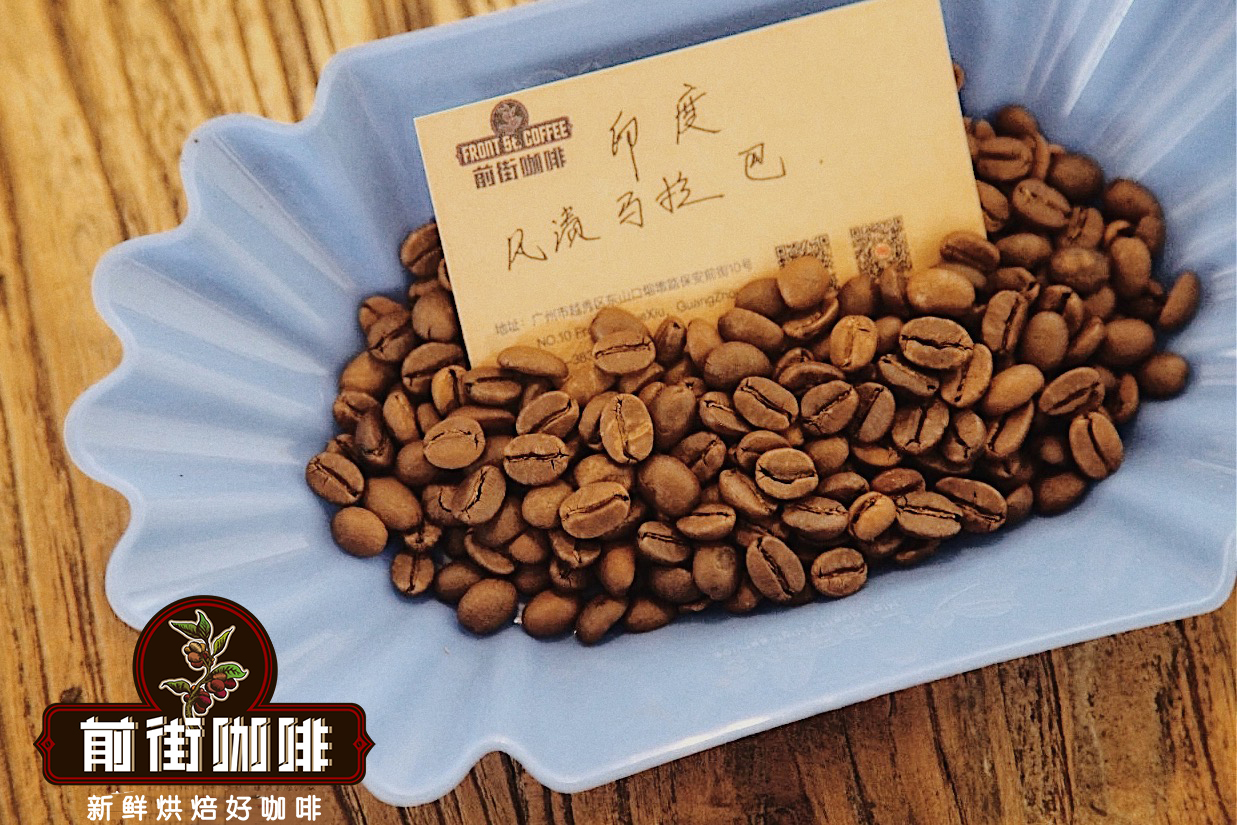
Front Street Coffee Indian style stained Malaba Coffee
Producing area: the coast of Malaba in southern India
Altitude: 1100-1200 m
Variety: Kents,S795,Catimor,selection 9
Treatment method: wind stain and sun treatment method
Cooking parameters: Kono filter cup, 1:15 ratio of powder to water, 15g coffee powder, medium and fine grinding (standard sieve 20 pass rate 70-75%)
The step-by-step extraction was performed with 30g steam for 30 seconds, small water injection to 125g, then water injection to 225g, and the whole extraction time was 2 minutes.
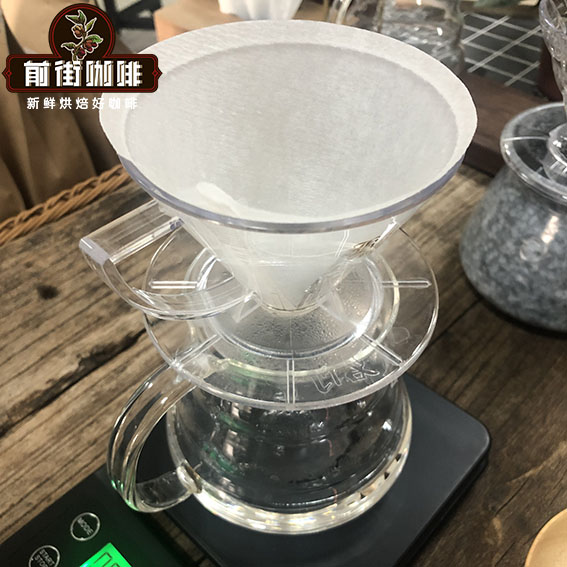
Flavor: rich aromas of caramel, raisins and herbs, with a berry finish and a taste like Xuanmi tea.
Viet Nam
The origin of Vietnamese coffee
Vietnamese coffee was brought to Vietnam by French Jesuit missionaries around 1860. in the past 150 years, Vietnam has gradually developed its own unique coffee culture. nowadays, walking along the street from Ho Chi Minh City, the largest city in the south, to the mountain city of Sapa on the border between China and Vietnam, you can often see canvas sheds and sunshades piled or clustered by the side of the road, with lounge chairs or hammocks or even small benches facing the road. There is a simple aluminum drip on the low table on one side, and people sit or lie down or cross their feet while sipping (not drinking, drinking, not sucking, licking, but must be sipping) capheda (iced coffee), coffee has been sipped, half a pack of cigarettes has been smoked, and it has been worn away in one morning or two or three afternoons.
Walking in the streets of Vietnam, cafes can be seen everywhere, and ordinary Vietnamese use Vietnamese coffee pots to slowly filter coffee to spend the afternoon. Vietnamese coffee is not brewed in a coffee pot, but in a special dripping coffee cup.
There are many countries famous for their unique coffee culture. Italy, France, the United States and Turkey all have their own origins and heritage, but Vietnam is still a little different. In Vietnam, the price of a cup of coffee ranges from 10,000 dong to 50,000 dong, and most shops do not exceed 20,000 dong, which is only equivalent to the price of a bottle of mineral water. Compared with the price of a bitter latte in China, it is a paradise for coffee lovers.
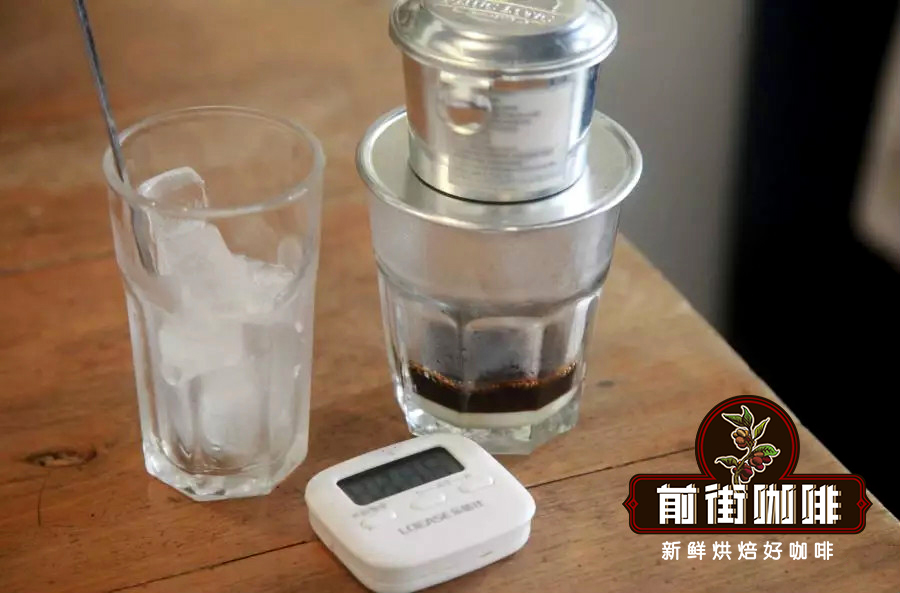
The most traditional
Drip condensed milk coffee
Vietnam was once a French colony, and the romantic and enjoyable French brought coffee culture here. After all these years, the Vietnamese still keep this old way of drinking coffee-dripping. The method is simple: sprinkle the coffee powder on the pressure plate of the dripping cup, press it and pour it into hot water, and the rest is to wait patiently for the coffee to slowly leak through the holes. However, the coffee obtained by dripping is so black and bitter that few people can enjoy it.
The creative Vietnamese poured thick condensed milk at the bottom of the cup, and this improvement had a miraculous matching effect: the rich sweetness of condensed milk and the bitterness of Vietnamese coffee were made for each other, and the sweetness was unimaginably strong, but it could not blend with the bitterness of Zhai coffee. Sweet and bitter tastes coexisted between the teeth, and friends who had been to Vietnam could not forget that taste.
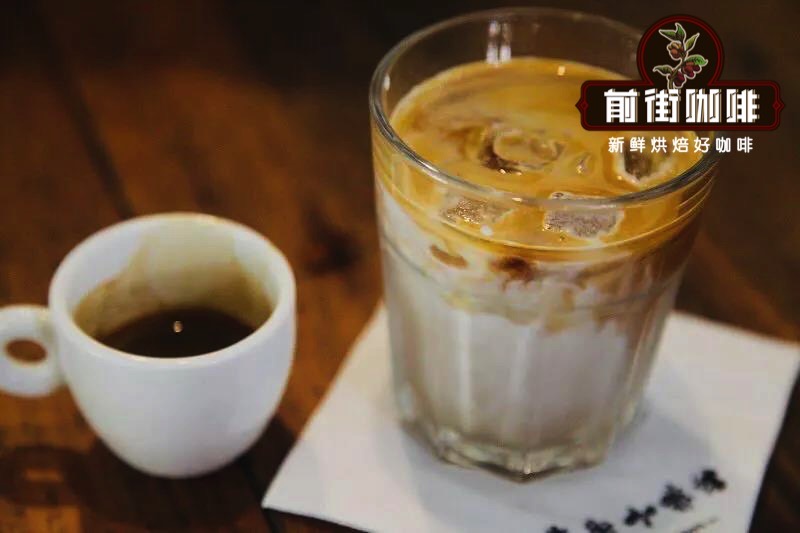
The most special
Egg white coffee
Just like a special cocktail made with base wine and egg whites, coffee can also be served with egg whites, which is egg white coffee that can only be tasted in Vietnam. Some people jokingly call it "Vietnam's cappuccino". The coffee shop owner is adept at separating the fresh eggs into the yolks and whites, and the whites are quickly foamed in the fast blender. The whites are ideally streaked, and then poured into the coffee that only covers the bottom of the cup. Carefully taste the special taste, the bitterness of the coffee neutralizes the smell of the eggs, and the whites also stimulate the aroma of the coffee-a great sense of satisfaction.
The freshest
Yogurt coffee
Air conditioning is not popular in most restaurants and beverage stores in Vietnam. Imagine walking for a long time in the 37-degree sun. If you enter a restaurant without air conditioning, you must not have much appetite to enjoy good food. Let's start with a cup of fresh yogurt coffee to appetizer.
Coffee is most afraid of sour, while the Vietnamese mix yogurt with coffee, which tastes surprisingly good. A cup of yogurt coffee tastes sour, fragrant, sweet and other levels of detail, so it tastes refreshing and burden-free. Such meticulous flavor changes can not be extricated with only one sip. In addition, Vietnamese yogurt is also praised by all travelers who have been there: mellow texture, sweet taste, perfect with coffee.
For more boutique coffee beans, please add private Qianjie coffee on Wechat. WeChat account: kaixinguoguo0925
Important Notice :
前街咖啡 FrontStreet Coffee has moved to new addredd:
FrontStreet Coffee Address: 315,Donghua East Road,GuangZhou
Tel:020 38364473
- Prev
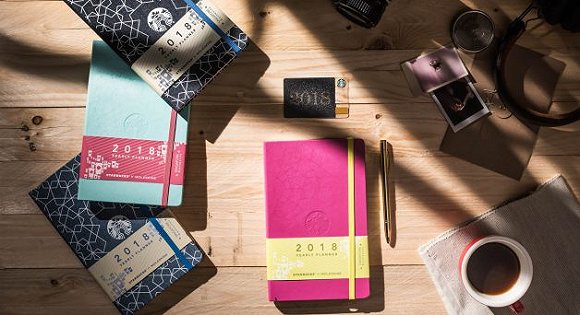
Starbucks still doesn't make enough money to sell coffee, but also cross-border sales accounts?
For professional baristas, please pay attention to the annual hand account of the coffee workshop (Wechat official account cafe_style). It may be an essential item on many people's year-end shopping lists. If you pay attention to this field, it is not difficult to find that there are many new cross-border players quietly as early as a few years ago. One of them is Starbucks, yes, the Starbucks that sells coffee. Starbucks has recently been in various parts of the world
- Next
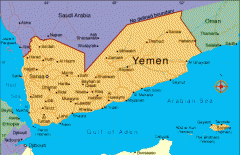
A brief introduction to the main coffee producing areas in Africa and their well-known representative coffee flavor characteristics
Professional baristas please follow the coffee workshop (Wechat official account cafe_style) Yemen (Yemen) well-known representative coffee: Mocha Mattari early Yemeni coffee is mainly exported from the port of Mocha, so the coffee exported from here is named after Mocha. Yemeni coffee in Mattari and mountain
Related
- What documents do you need to go through to open a coffee shop? coffee shop coffee shop certificate processing process
- How to purchase Coffee beans in small Cafe how to choose a suitable supplier for domestic Coffee supply Company
- How to drink Starbucks Fragrance White Coffee? how to make Australian White Coffee? what Italian coffee beans are recommended?
- The Story of Flora Coffee: the name of Flora Coffee Bean and the implication of the Flowers on Florna Coffee
- How much does a cup of coffee cost? How much is the profit of a cup of coffee? What is the profit of the coffee shop in a year?
- Yunnan small Coffee, known as "fragrant Coffee", introduces the characteristics of Alpine Arabica Coffee producing areas in Yunnan, China
- 2023 latest Starbucks full menu price list how much is a cup of Starbucks coffee what is better to drink the most popular hot and cold drinks recommended
- Starbucks different kinds of Coffee Price list Starbucks menu 2023 Top Ten Best drinks in Starbucks
- Starbucks Spring praise Comprehensive matching Coffee Bean theme Story Packaging implication and taste description
- The cost of a cup of coffee latte American coffee cost price and selling price

